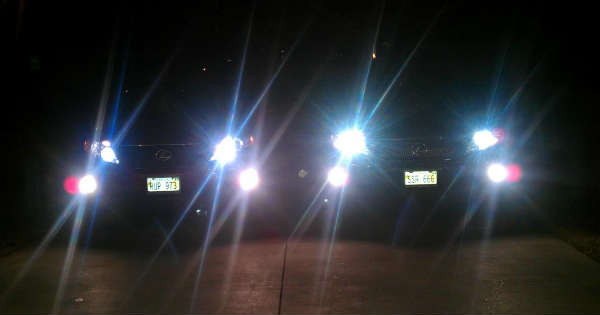If there’s anything that the last decade has shown us, it’s that the influx of newer and more advanced headlight options is threatening to dethrone halogen lights from its position in the top spot. If you’ve ever thought about the differences between HID and LED headlights, or the advantages each of them holds for automobile drivers, then that’s quite understandable. Luckily for you, you’ve stumbled upon the right place that will help you get a better grasp of these things.

Some of the questions we’ll answer are: In what ways do LED lights trump halogen bulbs? What are the differences between HIDs and LEDs? But before we get to all these, let’s start with the most common headlights on the market—the halogen bulbs.
Halogen Headlights
Argon and nitrogen are the gases that form halogen light. They are contained within a heat-resistant globe that contains a tungsten filament.
When your vehicle’s battery sends an electrical charge to the tungsten, the filament heats up to thousands of degrees. In turn, it emits the light you see from the outside of the bulb. You basically call this the process of incandescence.
On average, the lifespan of the halogen bulb is 800 hours. It eventually dies out because of the fracture and complete evaporation of its tungsten filament.
Some of the reasons this brand of headlights is so popular are it’s being low-cost, easily replaceable, dimmable, and universal. As for its downsides, you probably won’t like that it’s so sensitive, prone to overheat, and gives off intense energy.
HID Headlights
For years, no other headlight was able to give the halogen bulb a run for its money. Then, all of a sudden, a new light type entered the market and threatened to topple its position from the top spot. The HID headlight was the first product in decades to challenge the dominance of the halogen bulb, and that somehow remained a mystery to the majority of motorists.
HID headlights work in the same way as neon lights, where a high-voltage current passes through a tube filled with gas and has electrodes on both of its ends. With this type of light, the current that flows between each electrode stimulates the halide salts and xenon gas inside the quartz enclosure.
The rise in temperature then causes the metallic salts within the enclosure to evaporate, reducing the resistance between the electrical arc, which, from there, is subsequently sustained by the engine.
What makes HID headlights so great is their longer lifespan, brighter light, wider coverage, and greater efficiency. They also consume a lot less energy compared to halogen lights.
If you are, however, undecided about what to think about this product, like many motorists out there, then its high costs compared to the halogen bulb and powerful, blinding glare are going to do nothing to win you over.
LED Headlights
When it comes to unusual processes to produce light, LED headlights take the cake. The negative electrons in an LED lightbulb run against the holes found on a semiconductor to produce a diode that emits light. This is actually where the term “LED” comes from, as in light-emitting diode. When electrons pass through a hole with low energy, photons are released. You then call this process electroluminescence.
The repetitive occurrence of this process, which is known to occur more than a thousand times every second, produces the LED light.
There are plenty of reasons for this light type’s popularity, and they are mostly due to its compact size, energy efficiency, bright light (brighter than a halogen bulb’s), and absence of glare, unlike HID lights. It also has a few downsides, namely its high price, need for cooling, and high Kelvin readings that make it a mediocre performer in inclement weather.
Laser Headlights
The laser light is one of the latest to hit the market. It has been promoted profusely by the European market in the last ten years.
Laser lights are perhaps the closest we can get to futuristic light technology. Those who have been following this product’s progress over the years can’t help but think that it’ll only be a matter of time before it comes to rival the LED light.
You’re probably thinking about how dangerous lasers are, but they, surprisingly, have little to do in the luminescence of laser headlights. These lights actually depend more on the phosphor to produce light. You’ll find many top-of-the-line cars making use of these types of bulbs.
As far as brightness, coverage, package, and energy efficiency are concerned, there’s little any of the other products can do to beat this one. It’s way ahead of the pack in all these departments that it’s difficult to imagine how any person can choose any other type of light over their laser counterpart.
That said, one may hesitate once they get a good look at the price tag of these lights and the fact that they aren’t applicable as dual beams. Also, unluckily for people in the USA, laser lights aren’t legal in the region yet.
Conclusion
Halogen, HID, LED, and laser headlights each have their advantages and disadvantages. Your choice, though, will ultimately depend on your needs and the particular light bulb’s compatibility with your vehicle.
If you own a top-of-the-line automobile, it’s highly likely that it’ll have a more technologically-advanced light bulb that isn’t halogen. Discover more about these headlights when you go to this site.






















